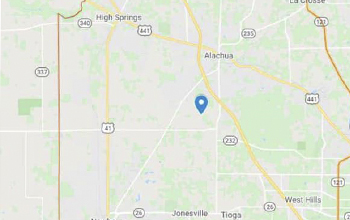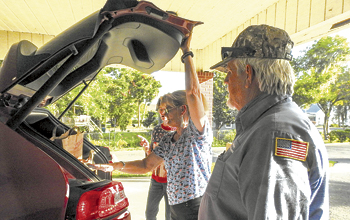Springs County, Hopeful Reality or Pipedream?
NEWBERRY – The last time a new Florida county was created was almost 100 years ago with the formation of Gilchrist County in 1925. Now there is a movement afoot among some people to create a county separate from Alachua County that would include the smaller municipalities in the western part of the county.
Springs County would include Newberry, Alachua, High Springs, Archer, and the western portions of Gainesville. Newberry City Commissioner Tim Marden, who is one of the leaders of the movement, says the idea began years ago, but has regained traction recently due to the pandemic. The issue of whether the Alachua County Board of County Commissioners (BOCC) has the right to set certain rules for municipalities, including mandating masks and business opening is key to the recent uptick in interest in the proposed new county.
Marden is proposing 34th Street (SR 121) as the dividing line, but the actual division would be drawn by the Florida Legislature, if approved. The idea of a separate Springs County has been around since at least 2015, but the complexity of doing so kept it an idea only among a small portion of the population.
Today Marden characterizes the action as a “political divorce” with much of its origins based on conservative ideology including less government influence in communities and individual lives, less restrictions on businesses, and more influence of churches and conservative organizations. The COVID crisis has played a part in the resurgence of the idea with opposition to the mask mandate and social distancing.
But the idea has grown beyond political lines. Much of the reason it has gained traction is that officials on both sides of the political spectrum in outlying communities feel they are not being listened to by the Alachua County BOCC, which centers much of their actions and tax funds on the more populous Gainesville. There seems to be an attitude among the commissioners that the outlying communities are responsible for their own growth and should be responsible for their own infrastructure. “But these residents of the smaller towns pay the same taxes and should have funding from that,” Marden said. All assets within the new county lines would belong to the new county, since they were already purchased by taxpayers according to Marden.
Newberry Mayor Jordan Marlowe said he has people contact him on a daily basis about Springs County and those individuals are republicans, democrats, those with no-party affiliation, and Gainesville residents. “This is no longer a partisan issue. This is no longer a small town versus urban issue…they’re clearly frustrated,” said Marlowe.
“I don't think creating a separate county is a good idea or even doable legally or financially, but it is clear that people are frustrated with the lack of representation on the BOCC.” Marlowe added that frustration stems from not only the belief that people are not being listened to, but also that decisions tend to be geared toward the Gainesville area.
“I would rather see more dialogue between the commission and the smaller rural communities,” Marlow said. “We have reached out to the commission multiple times but have not gotten much back and that is creating the problem.” He also realizes that a new county is just an idea, not a plan, and it would take a long time and a lot of money to bring it to fruition.
State Senator Keith Perry echoed that concern. “The problem in Alachua County is that since the majority of the population and voting block is based in the larger Gainesville area, the people voted onto the commission are mostly from Gainesville, and therefore have a vested interest in providing funding and infrastructure to their city, so I can understand the frustration from the outlying communities.” Perry said this creates friction between representatives from different towns and believes this is the impetus behind the idea of Springs County.
“There is currently not a lot of substance or research to the viability of creating a new county,” said Perry. He also said he had been approached by Marden about the idea. “The people behind the initiative need to provide more details for us to be able to research it or bring it up before the legislature, which has the only authority to approve such a move,” Perry said.
While Marden has not reached out to the mayors or city managers of the towns in the proposed county, he says there is a general feeling of frustration with communications and distribution of county funding among the outlying towns. City officials from Newberry, High Springs and Alachua do not favor splitting from Alachua County, which would be complex and costly and unlikely to achieve constructive results. Most are in favor of establishing improved communications and interaction with the BOCC leading to addressing concerns of the outlying communities and to have more input in BOCC decisions.
Currently, details of how a new county would operate are scarce. The main proposal as described by Marden and the Springs County group revolves around taxes and control of local businesses and government. The group proposes to eliminate property taxes to be replaced with a local sales tax, a step they say that would give more revenue to individuals and small businesses and also keep property from being seized for nonpayment of taxes.
However, if the county were to be created by the legislature, it would be starting with no tax revenue and would have to leave the property taxes in place until enough reserve was created to switch to a sales tax base. But the timeline on that is unknown. While the group believes that eliminating property taxes would attract new businesses and lower costs for existing businesses, it might also drive residents to shop in Gainesville where sales taxes would be lower, or online, which would hurt small businesses that make up the majority of businesses in the smaller towns.
Marden explained the change wouldn’t mean that taxes will go down right away, “Those taxes will just kind of keep going and being basically the same for a little while,” Marden said. “I think there’s an opportunity to drive the expenses of government down significantly, right off the bat, and if we maintain the taxes for a year or two, the spread can be plowed into a lot of the infrastructure projects that have been otherwise neglected.”
The concept of removing property taxes would be to drive down the scope and scale of the county government, focusing on core services such as roads, public safety, utilities, and courts. Individual families, businesses, civic groups, and churches would be responsible for social programs and charities.
Property taxes are required by the state for public school funding and water management districts, as multi-county governing bodies, also levy taxes. The group is also supporting a gas tax to fix the roads, especially county roads that would become the responsibility of Springs County. Currently, outlying towns struggle to get the BOCC to improve or resurface roads. There is presently no research on whether a gas tax would produce enough revenue to replace property taxes, which are also used for road construction. Marden plans to ask the state for property tax records for the proposed area to see if the sales and gas tax would produce enough to replace it.
As far as incorporating the schools into a new county, they will largely stay the same per state requirements. Students attending magnet programs would hopefully benefit from a grandfather clause in any legislation creating Springs County. The group believes that teachers should focus on teaching and there should be more responsibility on parents for food and after-school care services.
While the School Board of Alachua County (SBAC) has a $423 million budget, teachers in Alachua County are among the lowest paid in the state. How much of a budget the schools in a newly created county would have remains unknown.
A new county would also require maintaining or creating new fire and police departments. While Marden says some first responders would leave to stay within the Alachua County retirement system, the departments would be smaller based on a primarily rural area.
Newberry currently has its own fire department but uses the Alachua County Sheriff’s Office (ASO) for police protection, meaning the city would have to create its own department, as would Archer. The City of Alachua has a police department but uses fire services from Alachua County. High Springs has both fire and police departments.
A new county would also have to create a county commission with members from each community. Marden says that currently, residents interested in attending BOCC meetings have to travel to Gainesville and he believes that creating a local commission would mean more citizen participation.
The idea of Springs County has gained traction with some people, but there is little quantifiable data available to support its creation or sustainability—information that is necessary before any proposed legislation can be considered.
# # #
Email rcarson@
alachuatoday.com
Add a comment





